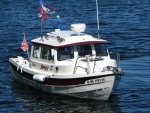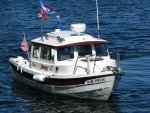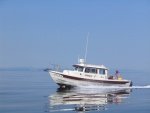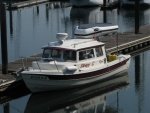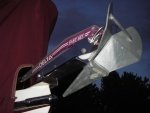The only company which I know of which did videos of setting and dragging, was Super Max (There have been some others in sand and out of the water). SuperMax is now being made again, and it has a reputation among cruising boats as one of the best anchors, in mud, as well as sand and rocks. They are awkward to store (what's new, with 3rd generation anchors). They now make one C Dory size.
http://maxmarineproducts.com/supermax-anchors/
As for diving--I have done a lot of diving on anchors, from just setting to holding in up to 80 knots, where the all chain rode is bar tight.
Kellets: Most cruising boats do not use them. As above when it really starts blowing the chain becomes bar tight, no matter what weight you put on the chain, or chain rode interface. The hassle of having to shackle on in place--especially if you have to move in the middle of the night, because of changing wind directions etc, can be down right difficult, if not dangerous. I tried and found it made no difference. (We did carry a 35# pig with an 5/16" eye bolt I molded in). The general consensus is it is better to have an anchor which weighs 30# more, which more fluke area, than the hunk of lead. An anchor does not hold by its weight--it holds by the action of the flukes. Even in digging in, the weight has little value in modern anchors--such as the Fortress, or the 10# Boss I am currently using.
Peter Smith and Ronca vs Manson. Peter bad mouthed Manson. There were tests done, and Manson showed that their anchors were as strong, if not stronger than Ronca. In practical tests they both seem to work equally, as well as in strain gauge tests. There was a bad bunch of Roncas, when first being made in China. I believe that is well in the past now. No reason for "Anchor Wars". They are both good anchors. One copies the other?
The Guardian Vs Fortress: Same high tensile strength alloy, the edges of the fluke are sharper, the finish is better because of anodizing. The second hole, with 45 degree fluke angle was tested well in the year or so ago Fortress test, and is definitely superior in the less cohesive mud.
One always have to remember that comparative anchor testing is difficult because of so many variants in the sea bed. Testers try and fine uniform areas, but that is difficult, and once an anchor has plowed thru the bed, it is not the same, for the next anchor. Most of us have had the experience of anchoring one place in a cove, and the anchor not holding--but moving a few feet and it works beautifully.
Anchoring is an art. There is no one perfect anchor. When we cruised we always had 3 anchors on the ready at the bow. One Fisherman, one plow, one Danforth.
Today, I would have one Ronca/Manson Supreme/Boss??? , one Fortress, and one Fisherman on the bow. Just because we have 3rd generation anchors, there still is no one perfect anchor. You have to know the sea bed, and what the anchor will do. For me, the 3 Guardian/Fortress, total weight maybe 12 to 14#, broken down under the dinette floor, plus one Boss, or Manson on the bow, seems good enough for anything I meet in our cruising. But, If I was going to the Bahamas, or some areas where there are extensive sea grasses, I would have a fisherman (or perhaps the SS Northie, Sea Plane Anchor , I just sold... in the kit....
